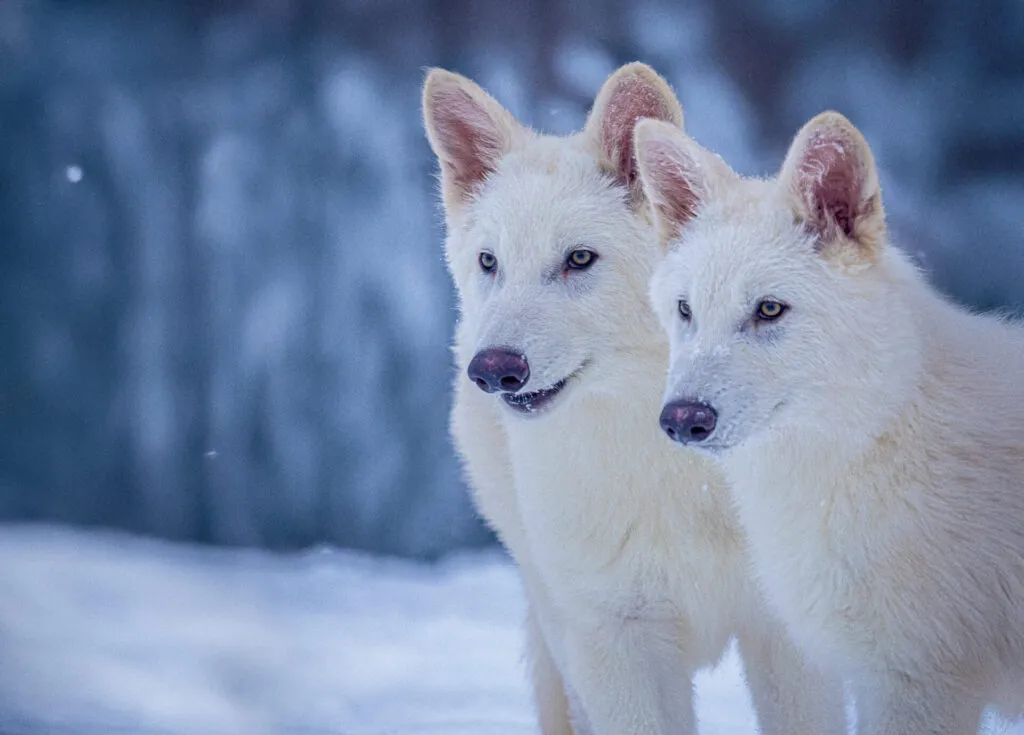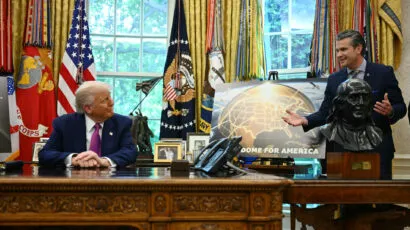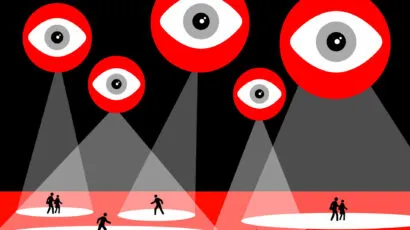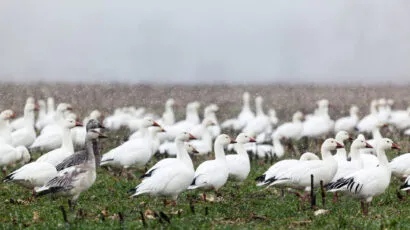Dire wolf, or Colossal misrepresentation?
By Jessica McKenzie | April 10, 2025
 Three-month-old wolf pups, Romulus and Remus. (Photo courtesy of Colossal Biosciences)
Three-month-old wolf pups, Romulus and Remus. (Photo courtesy of Colossal Biosciences)
Amid a supremely chaotic news environment—dominated by Trump’s deportations, Trump’s funding cuts and layoffs, Trump’s tariffs and, of course, the tumultuous stock market the tariffs produced—one carefully calibrated science story managed to break through the noise and make global headlines this week: A biotechnology company called Colossal Biosciences claims to have resurrected the dire wolf, a species that went extinct over 10,000 years ago.
In case you haven’t already read a dozen stories about this, here are some of the most salient details: Scientists at Colossal retrieved DNA from an approximately 13,000-year-old dire wolf tooth and from the inner ear bones of a 70,000-year-old dire wolf skull. From the extracted DNA, they were able to sequence the dire wolf’s genome—up to 91 percent of it, at least—and study it to determine what makes a wolf “dire.”
Colossal’s scientists then took cells from a gray wolf—with whom the dire wolf shares 99.5 percent of its DNA—and used CRISPR to edit the genes to be more like a dire wolf. In total, they made just 20 changes to 14 genes; no actual dire wolf DNA was spliced into the gray wolf DNA. Then they took the modified gray wolf DNA, inserted it into dog ova that had the dog’s genetic material removed, and placed 45 of those engineered embryos into eight surrogate dogs. (That’s 45 embryos per dog, to be clear.) Those approximately 360 embryos netted three apparently healthy wolf pups: two males and a female.
The question is whether making 20 changes to gray wolf DNA is enough to call the resulting animals “dire wolves.”
“[If] it looks like a dire wolf and acts like a dire wolf, I’m going to call it a dire wolf,” Beth Shapiro, Colossal’s chief science officer, told Wired. “And my colleagues who are taxonomists will disagree with me,” she conceded. But also, the genetic changes they made all targeted how a dire wolf might look; the New Yorker reported that “no effort had been made to try to identify genes for behavior.”
Other scientists also disagree with Shapiro: “The work that’s being done at Colossal has not brought a species back from extinction,” Jacquelyn Gill, a paleoecologist at the University of Maine, told the Bulletin. “[It’s] a genetically modified wolf.”
Colossal gave non-exclusive access to the three wolf pups and to the embargoed story about their achievement to some of the nation’s most prominent publications, including Time, the New Yorker, and Wired. This virtually guaranteed a media blitz when the stories finally dropped, all on the same day. The resulting media frenzy provides a fascinating case study of science journalism.
Let’s start with the headlines. Some of the most credulous include:
“The Return of the Dire Wolf” in Time.
“The Dire Wolf Is Back” in the New Yorker.
“Life After Death” in the print edition of the New Yorker.
“The dire wolf, which went extinct 12,500 years ago, revived by biotech company” in CBS News.
“Dire wolves brought back: See photos of Romulus, Remus and Khaleesi” in USA Today. (Romulus, Remus, and Khaleesi are the names of the wolves in question.)
This list might be a bit repetitive, but it’s illustrative of the overwhelming volume and tone of the coverage.
Other outlets hedged their bets a bit: “Scientists Claim to Have Brought Back the Dire Wolf” in Wired; “Scientists Revive the Dire Wolf, or Something Close” in the New York Times; “Did Scientists Actually De-Extinct the Dire Wolf?” in Scientific American; “A biotech company says it has bred three pups with traits of the extinct dire wolf” in NPR. Still others eventually pushed back on Colossal’s claims: “Scientists say they brought back dire wolves from extinction. Not exactly” in the Washington Post; “No, the dire wolf has not been brought back from extinction” in New Scientist; “Experts dispute claim dire wolf brought back from extinction” in the BBC. You get the idea.
In general, the stories that unequivocally affirmed Colossal’s de-extinction achievement in the headline came out first—or were chasing search-engine attention with regurgitated versions of those initial articles. The stories with a more skeptical perspective were published in a subsequent wave after scientists and science writers began disputing the company’s claims.
It’s important to consider how sausage like this is made, and I mean the stories—not the actual wolves. None of the reporters I contacted or Colossal would confirm exact details on the record, but it is clear that Colossal reached out to a relatively few handpicked journalists or publications who agreed to an embargo specifying when publication of articles could occur. (Update: A Colossal publicist confirmed in an email that “yes, we had journalists sign [nondisclosure agreements] before sharing the news around the announcement.”)
Though a matter of some controversy in media circles, such embargoes are fairly common in the world of science journalism, where they are often rationalized with claims that journalists need significant amounts of time when dealing with complex subjects.
Colossal would have begun by meting out interviews to its chosen journalists—by phone, video call, or in person—with scientists, executives, and animal caretakers. The company had to arrange times for the journalists to come see the two males in their enclosure (at an undisclosed location in the northern United States). Those were likely separate visits, because none of the journalists mention seeing their peers on the premises. But it’s theoretically possible there was one big, coordinated press trip, and the writers don’t mention it because it could be distracting or draw attention to the sausage-making process.
It’s interesting from a craft perspective to consider how different journalists handled the same general material—which details crop up where, and how. For example, Wired and the New York Times reported that a fourth pup was born at the same time as Khaleesi but died after 10 days from an infected or ruptured intestine, but neither the New Yorker nor Time included that information.
Jeffrey Kluger reported for Time that the two male pups (who were born first, before the female) were initially kept together with the surrogate that displayed the most maternal instincts, but after a few days were removed because “the surrogate was actually becoming too attentive.” Max, on the other hand, wrote in the New Yorker that the wolves were initially nursed by one of the surrogates, but switched to bottles because the dog couldn’t “keep up with their metabolic needs.”
Crucially, the stories written in advance by journalists with early access uniformly lack substantive criticism or questioning of Colossal’s work on dire wolves from scientists unaffiliated with the company, presumably because they were barred from sharing specific details about the dire wolf project outside the company until the embargo lifted.
Mullin and Reynolds included a vague quote in their article from David Jachowski, a professor of conservation at Clemson University, about the tricky nature of defining species, but carefully stated that Jachowski “did not know specific details about the dire wolf project.”
“I really feel that bringing back one or even five woolly mammoths is not a good idea,” Yale University bioethicist Stephen Latham told Kluger. “A single woolly mammoth is not a woolly mammoth leading a woolly mammoth life with a woolly mammoth herd.” Presumably, Kluger asked about the woolly mammoth because Colossal’s desire to bring a woolly mammoth back from extinction is well-known public information and therefore fair game, unlike the dire wolf project.
Max spoke with one scientist who expressed skepticism about Colossal’s messaging—Elinor Karlsson, an expert in wolf and dog genetics. “I ask Beth [Shapiro], ‘Why are you calling this a dire wolf when it’s a gray wolf with seventeen or eighteen changes in its DNA?’” Karlsson told Max. But Karlsson is on the company’s advisory board.
Under normal circumstances, journalists who agree to an embargo hold their stories until a pre-arranged date. Shapiro, Colossal’s chief science officer, told Andrea Thompson, an editor at Scientific American, that the mainstream media stories were supposed to coincide with the publication of a scientific article backing up some of their work, but the New Yorker broke the embargo, unleashing the floodgates of media coverage before the scientific article could be published. (Max, the New Yorker staff writer assigned to the story, declined to comment.)
The deluge of articles on Colossal’s work took the scientific community by surprise. Many scientists argued that the gray wolf is not the dire wolf’s closest living relative, citing a 2021 paper that found dire wolves diverged from living canids 5.7 million years ago, and from African jackals 5.1 million years ago, making them genetically closer to the jackal. But Colossal says their more complete genetic analysis shows that dire and gray wolves shared common ancestors as recently as 2.5 to 3.5 million years ago, according to Wired.
But scientists have to take Colossal at their word, because their work has not been published or peer reviewed.
“This is not how we normally do science,” said Gill, a paleoecologist. “We don’t do science by press release in the absence of a paper. We don’t do science by New Yorker and Time magazine announcements.”
The result of Colossal’s extensive and carefully constructed promotion was a series of detail-rich feature stories that prominently repeated Colossal’s claims with virtually no pushback from outside experts. Other outlets quickly followed with their own stories based on those first few features and on Colossal’s press release. Some of those journalists sought outside expert input; some didn’t.
Gill had a visceral response when she first saw the headlines, like a gut punch. “It was an emotional roller coaster,” Gill said. “In terms of the very credulous way in which the media was essentially acting as an effective PR arm for Colossal—[that] was really shocking to me.”
Gill is worried that the frenzied media coverage will be detrimental to the public’s understanding of conservation and extinction, but also that the subsequent backlash will undermine the public’s trust in science. “This kind of messaging is really hard to walk back from,” she said.
The response she has observed has been polarized. Some people have responded that scientists shouldn’t be playing God, which could reduce support for essential biomedical research in general. Others have expressed a kind of manic enthusiasm, relieved that we no longer need to worry about the biodiversity crisis because humans can just bring species back from extinction.
This latter view was espoused by none other than Interior Secretary Doug Bergum, who put out a statement that said, in part:
“The Department of the Interior is excited about the potential of ‘de-extinction’ technology and how it may serve broader purposes beyond the recovery of lost species, including strengthening biodiversity protection efforts and helping endangered or at-risk species. The Endangered Species List has become like the Hotel California: once a species enters, they never leave. In fact, 97 percent of species that are added to the endangered list remain there. This is because the status quo is focused on regulation more than innovation… Since the dawn of our nation, it has been innovation – not regulation – that has spawned American greatness. The revival of the Dire Wolf heralds the advent of a thrilling new era of scientific wonder, showcasing how the concept of ‘de-extinction’ can serve as a bedrock for modern species conservation.”
Shapiro and Colossal CEO Ben Lamm told Wired that they hope media coverage of their “dire” wolves will raise awareness about the plight of the gray wolf. That’s not what I see happening—in the public sphere, or in the places it matters most, like the Interior Department.
Remus, Romulus, and Khaleesi will live out their lives in pampered confinement. Colossal’s leaders have said that the animals they create are not just “curios” but are meant to be reintroduced to the landscape so they can fulfill the same ecosystem functions as they did in the past. And yet, the three wolf clones will not be rewilded. Presumably the others that follow won’t either. Lamm has said they plan to make seven or eight.
Basically, the so-called dire wolves can’t be rewilded. Gill said that whether woolly mammoths died because they were hunted to death by humans, or because of climate change, or some combination of the two, is up for debate. But scientists know what happened to the dire wolves: They starved to death. “Regardless of what caused the extinction of most of these large grazers, the animals that ate them died because they had nothing to eat,” Gill said. “That has not changed. In fact, it has gotten more so over time as we’ve lost more and more of our wild spaces and more and more of the places where big animals would roam.” It makes no sense to start a (hypothetical) rewilding project with a large, charismatic predator before introducing its potential prey. If dire wolves couldn’t compete with gray wolves and coyotes back then, when large prey animals were more abundant, there’s no way they could compete now, Gill concluded.
“We’re not making a wild population, but we’re also not making a curio in a park,” Gill said, summarizing Colossal’s conflicting positions. “What are you doing? What is the point?”
And what about the journalists who spread Colossal’s message, largely without checks on the company’s narrative?
It’s hard to blame the journalists for agreeing to whatever terms Colossal imposed on their initial access—I would likely have accepted an embargo, too, if offered the opportunity. And the stories do raise some important ethical and practical questions about de-extinction.
But when the company you’re writing about is given the first and last word, and most of the words in between, are readers really getting the whole story?
Together, we make the world safer.
The Bulletin elevates expert voices above the noise. But as an independent nonprofit organization, our operations depend on the support of readers like you. Help us continue to deliver quality journalism that holds leaders accountable. Your support of our work at any level is important. In return, we promise our coverage will be understandable, influential, vigilant, solution-oriented, and fair-minded. Together we can make a difference.
Keywords: Department of Interior, Endangered Species Act, conservation, de-extinction, endangered species, rewilding
Topics: Climate Change
















Great article contextualizing one science story in the landscape of cloned, controlled and underfunded journalism. I’m glad I didn’t feed on the media frenzy about this topic and read your article first. What’s most disturbing is the Department of Interior’s statement that creepily gels with Silicon Valley’s “make it and break it” philosophy. Innovation needs to be matched with ethical realism.